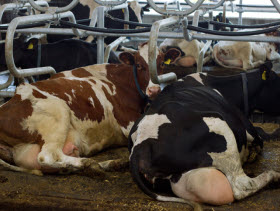



Modern Dairying Means Cow Signals Must be Picked Up
Larger herd size means monitoring cow health is increasingly difficult without help from rumination sensors, says dairy expert Marcia Endres.She writes that studies have found the first 40 days of lactation are statistically more likely to see cows die. Mrs Endres, of University Missouri Dairy Extension recommends monitoring rumen and animal health to nip problems in the bud early.
Cool New Ways to Really Listen to Your Cows
For many years now you have heard me say things like, "your cows are talking, are you listening?" We have paid more attention to daily production records, scored cows for lameness, lesions, body condition, hygiene, and documented disease incidence and mortality. Yes, cows are talking to us by these outcome measures. They are important indicators of cow well-being. Are there other ways we could more directly listen to our cows, every day, on the farm?
As dairies get larger and cows are housed in larger groups, it becomes more difficult to identify sick cows. Cows are managed as groups, not individuals. We can no longer go to the tie-stall barn, look at each cow and know whether or not she ate today. Rumination is an indicator of a properly functioning rumen and of animal health. However, rumination hasn't been an easy parameter to track. But exciting new precision dairy technologies, such as rumination/activity/temperature sensors can really listen to our cows, 24 hours a day, even in the middle of the night when nobody is around.

Temperature, rumination and activity are some of the signals cows send to communciate health disorders
In one of our recent studies investigating ~6,000,000 DHIA records from the upper Midwest, we learned that the greatest proportion of cow mortalities on farm occur in the first 40 days in milk. The transition period is the most critical for a dairy cow. Monitoring cows for activity, rumination, and temperature can really help with early detection of health disorders, since a drop in rumination occurs before a drop in milk production or physical symptoms appear. Treating cows earlier will help prevent large drops in production and reduce cow mortality on the farm.
*
"The monitoring software is better than our eyes at seeing the cow's response. This can help save dollars in treatment costs too."
A research study in Israel that followed cows from dry off through 150 days in milk showed a gradual decrease in rumination time in the last two weeks before calving, a sudden drop at calving, and a rapid increase in rumination in the days following the calving date. After about a week, cows reached their maximal daily rumination time and stayed relatively stable. This information has been used in farms equipped with rumination (and activity) monitoring neck collars to track the smooth transition from the dry period into the next lactation. Any deviation from this normal pattern can indicate the start of one of the common calving disorders (e.g. milk fever, retained placenta, metritis, or ketosis), so the producer can check the animal and promptly diagnose and treat it.
After treatment/intervention, monitoring rumination patterns can also help dairy producers verify if the cow has recovered. The monitoring software is better than our eyes at seeing the cow's response. This can help save dollars in treatment costs too. Using these technologies will result in healthier herds, something that our general public would welcome. Everyone would like to know that we are listening to our cows. These monitoring systems are also used for heat detection, so it is recommended that cows wear them from the pre-fresh period until 60 to 80 days after confirmed pregnant. But I am really excited about early detection of disease. That is huge!
Funk's Midway Dairy in New Munich, Minnesota2, has been using one of these sensor technologies (the Heatime® HR Tag from SCR Dairy), which allow them to track rumination, in addition to activity monitoring, enabling the dairy personnel to see deviations from normal activity. Since the system has been integrated into the Funk's 600-cow dairy, transition cow management has been streamlined–and more effective. At 3:00 a.m. an employee goes over the rumination report to determine which cows need attention. "Instead of spending time eyeballing all the cows, we go straight to those one or two cows that need attention," says Karl Funk.
"We realized we were over treating about half of our mastitis cases," notes Funk. "Also, before the SCR system was in place, we would drench cows with ketosis twice a day for two weeks. Now, in the second week, we usually drench only once a day and sometimes the system tells us they're healthy enough to not need further treating. If cow health is important to you, the rumination monitoring makes the system pay for itself–and that's without even considering the heat activity part," Funk concludes.


